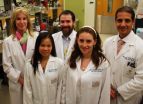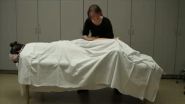(Press-News.org) An international research team led by Cesar A. Arias, M.D., Ph.D., at The University of Texas Health Science Center at Houston (UTHealth) has identified a new superbug that caused a bloodstream infection in a Brazilian patient. The report appeared in the April 17 issue of The New England Journal of Medicine.
The new superbug is part of a class of highly-resistant bacteria known as methicillin-resistant Staphylococcus aureus or MRSA, which is a major cause of hospital and community-associated infections. The superbug has also acquired high levels of resistance to vancomycin, the most common and least expensive antibiotic used to treat severe MRSA infections worldwide.
Most worrisome is that genomic analyses indicated that this novel vancomycin-resistant MRSA superbug belongs to a genetic lineage that is commonly found outside hospitals (designated community-associated MRSA), said Arias, the report's senior author and an associate professor of medicine, microbiology and molecular genetics at the UTHealth Medical School.
Previous research has suggested that community-associated MRSA can disseminate rapidly among people and is responsible for the majority of skin and soft tissue infections (sores) in patients of all ages. Some of these infections can become serious and even fatal.
Since community-associated MRSA is thought to be transmitted mainly by skin contact, the new superbug may affect not only sick people or those with a weakened immune system but also healthy individuals, according to Arias. Apart from causing localized skin infections, the MRSA superbug has the ability to invade the bloodstream and may become a serious threat.
"This is the first-ever reported bloodstream infection caused by a highly vancomycin-resistant MRSA bacteria," Arias said. "If we lose vancomycin, it would make it very difficult and expensive to treat these infections," he said.
Arias and his colleagues conducted microbiological and genetic analyses of an MRSA superbug recovered from the blood of a 35-year-old Brazilian man and identified a novel transferable genetic element (plasmid) that carries the genes necessary for vancomycin resistance (vanA gene cluster).
"The presence and dissemination of community-associated MRSA containing vanA could become a serious public health concern," report the authors in the paper.
However, since this is the only documented case of this type of infection, Arias said, it is too early to tell if this specific superbug will lead to a bigger threat.
Barbara E. Murray, M.D., report co-author and director of the Division of Infectious Diseases at the UTHealth Medical School, said, "The worst resistance possible has now appeared in the community-associated MRSA clone."
What is the next step?
"There will have to be increased surveillance in South America and worldwide in the future," said Murray, who is the holder of the J. Ralph Meadows Professorship in Internal Medicine at the UTHealth Medical School and president of the Infectious Diseases Society of America.
INFORMATION:
Arias leads the UTHealth Medical School Laboratory for Antimicrobial Research, which focuses on studying the clinical and molecular aspects of antibiotic resistance, attempting to understand the complex mechanisms by which superbugs become resistant to antibiotics and then designing new strategies to fight them.
Arias is also the founder and scientific director of the Molecular Genetics and Antimicrobial Resistance Unit at Universidad El Bosque in Bogota, Colombia and co-directs the International Center for Microbial Genomics at the same university. These research units have become a major surveillance center for resistance pathogens in South America. The collaborative work derived from these laboratories has identified novel trends in antimicrobial resistance and has characterized the emergence of particular superbugs in the region.
Additional UTHealth faculty members contributing to the report include Diana Panesso, Ph.D.; Truc T. Tran, Pharm.D; Jinnethe Reyes, M.Sc.; and Jose M. Munita, M.D.
Co-authors from the Hospital das Clinicas de Faculdade de Medicina da Universidade de Sao Paulo, Brazil include Flávia Rossi, M.D. Ph.D.; Thais S.R. Di Gioia, M.D.; Andre Doi, M.D.; Denise Brandao, M.D.; and Inneke Marie van der Heijden, Ph.D.
Co-authors from the Molecular Genetics and Antimicrobial Resistance Unit, Universidad El Bosque, Bogota, Colombia, include Lorena Diaz, Ph.D.; Sandra Rincon, M.Sc.; and Lina P. Carvajal, B.Sc.
Also contributing to the report were Aye Wollam, B.Sc.; Yanjiao Zhou, Ph.D.; and George M. Weinstock, Ph.D., all of Washington University in St. Louis; Paul J. Planet, M.D., Ph.D.; Apurva Narechania, M.A.; and Galen Xing with Columbia University and the American Museum of Natural History in New York. Alejandra Hernandez-Roldan, M.Sc., Centro Internacional de Entrenamiento e Investigaciones Medicas, Cali, Colombia, contributed to the report.
Arias and Murray are on the faculty of The University of Texas Graduate School of Biomedical Sciences at Houston.
The report, "Transferable Vancomycin Resistance in Community-Associated MRSA Lineage," received support from National Institute of Allergy and Infectious Diseases (RO1 AI093749) and National Institutes of Health (1U54 HG004968).
New MRSA superbug emerges in Brazil
2014-04-17
ELSE PRESS RELEASES FROM THIS DATE:
Study IDs new cause of brain bleeding immediately after stroke
2014-04-17
Irvine, Calif., April 17, 2014 — By discovering a new mechanism that allows blood to enter the brain immediately after a stroke, researchers at UC Irvine and the Salk Institute have opened the door to new therapies that may limit or prevent stroke-induced brain damage.
A complex and devastating neurological condition, stroke is the fourth-leading cause of death and primary reason for disability in the U.S. The blood-brain barrier is severely damaged in a stroke and lets blood-borne material into the brain, causing the permanent deficits in movement and cognition seen ...
20 years of data shows treatment technique improvement for advanced abdominal cancer
2014-04-17
WINSTON-SALEM, N.C. – April 17, 2014 – Meaningful long-term survival is possible for selected patients suffering from advanced cancer of the abdomen when treated with cytoreductive surgery with Hyperthermic IntraPeritoneal Chemotherapy, or HIPEC, according to a first-of-its-size analysis by physicians at Wake Forest Baptist Medical Center.
Wake Forest Baptist has the largest reported, single-center experience with cytoreductive surgery and HIPEC, said lead author Edward A. Levine, M.D., and analysis of 20 years' worth of patient data shows that outcomes have clearly improved ...
Surprising material could play role in saving energy
2014-04-17
One strategy for addressing the world's energy crisis is to stop wasting so much energy when producing and using it, which can happen in coal-fired power plants or transportation. Nearly two-thirds of energy input is lost as waste heat.
Now Northwestern University scientists have discovered a surprising material that is the best in the world at converting waste heat to useful electricity. This outstanding property could be exploited in solid-state thermoelectric devices in a variety of industries, with potentially enormous energy savings.
An interdisciplinary team led ...
How vision makes sure that little fish do not get carried away
2014-04-17
This news release is available in German. Our eyes not only enable us to recognise objects; they also provide us with a continuous stream of information about our own movements. Whether we run, turn around, fall or sit still in a car – the world glides by us and leaves a characteristic motion trace on our retinas. Seemingly without effort, our brain calculates self-motion from this "optic flow". This way, we can maintain a stable position and a steady gaze during our own movements. Together with biologists from the University of Freiburg, scientists from the Max Planck ...
Massage therapy improves circulation, eases muscle soreness
2014-04-17
VIDEO:
Massage therapy improves general blood flow and alleviates muscle soreness after exercise, according to a study by researchers at the University of Illinois at Chicago.
Click here for more information.
Massage therapy improves general blood flow and alleviates muscle soreness after exercise, according to a study by researchers at the University of Illinois at Chicago.
The study, reported online in advance of print in the Archives of Physical Medicine and Rehabilitation, ...
Food shortages could be most critical world issue by mid-century
2014-04-17
WASHINGTON, D.C. -- The world is less than 40 years away from a food shortage that will have serious implications for people and governments, according to a top scientist at the U.S. Agency for International Development.
"For the first time in human history, food production will be limited on a global scale by the availability of land, water and energy," said Dr. Fred Davies, senior science advisor for the agency's bureau of food security. "Food issues could become as politically destabilizing by 2050 as energy issues are today."
Davies, who also is a Texas A&M AgriLife ...
Internet use may cut retirees' depression
2014-04-17
Spending time online has the potential to ward off depression among retirees, particularly among those who live alone, according to research published online in The Journals of Gerontology, Series B: Psychological Sciences and Social Sciences. In the article "Internet Use and Depression Among Retired Older Adults in the United States: A Longitudinal Analysis," the authors report that Internet use reduced the probability of a depressed state by 33 percent among their study sample.
Late-life depression affects between 5 and 10 million Americans age 50 and older. This new ...
A cross-section of the universe
2014-04-17
An image of a galaxy cluster taken by the NASA/ESA Hubble Space Telescope gives a remarkable cross-section of the Universe, showing objects at different distances and stages in cosmic history. They range from cosmic near neighbours to objects seen in the early years of the Universe. The 14-hour exposure shows objects around a billion times fainter than can be seen with the naked eye.
This new Hubble image showcases a remarkable variety of objects at different distances from us, extending back over halfway to the edge of the observable Universe. The galaxies in this image ...
Researcher looks at public perceptions around newborn testing
2014-04-17
TORONTO, April 17, 2014—While 94 per cent of Canadians surveyed said they would participate in public health programs that screen newborns for a specific number of genetic conditions, only 80 per cent said they would be willing to participate in screening that would sequence their newborns' genomes.
Most newborns in North America have a "heel prick test" in their first day or two of life in which a tiny amount of blood is taken from their heels and tested for about five to 54 conditions, depending on the state or province. Some conditions commonly tested for include cystic ...
Adrenaline does little to increase patient's survival after cardiac arrest
2014-04-17
TORONTO, April 17, 2014— Giving patients adrenaline after they suffer a cardiac arrest outside of a hospital does not increase their prospects of surviving long-term, according to new research conducted at St. Michael's Hospital.
"The vast number of patients who have a cardiac arrest get adrenaline, which has been the drug recommended in treating cardiac arrest for decades," said Dr. Steve Lin, an emergency physician and trauma team leader at St. Michael's. "Yet, despite advances in medical treatment, long-term survival rates of patients who suffer a cardiac outside a ...






